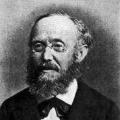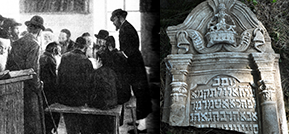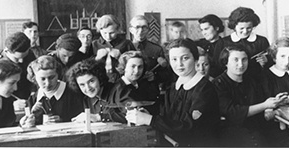
Ascher Selig Lauterbach was born in 1826 in Drohobych to a family of salt merchants. His father, Yaakov Betzalel ben Zvi, was born in Bavaria in 1800; his
mother, Rachel (1805-1860), was the daughter of David Mandel, one of the most prominent Jews in Buchach. Before his marriage to Haya Basya Bachsteg, Ascher Selig Lauterbach passed an exam in German and mathematics, and in 1850, before it became common for Jews to do so, was granted citizenship in Drohobych (he was only one of only four Jews who received citizenship before 1867). Ascher Selig Lauterbach began his career as a merchant, at the same time writing articles for the Lemberg newspapers Hatzir, Hamashber and Hanesher. In 1864 he requested a permit to own land. When the exploration of Galician oil fields was started in 1850-1960-s, Ascher Selig Lauterbach became an active participant of this rapidly growing industry. The best known of his activities in this field is his ownership of the Apollo-Naphta Parafin and Parfin Candle factory "Goldhammer, Gartenberg, Lauterbach, Wagmann" (established 1862). The factory refined ozokerite, one of the specific products of Galician oil wells, and produced candles. The refinery was one of the largest in the region. In 1872 it created the “First Galician Oil Company” with a capital investment of 1 million gulden. In 1880, the emperor Franz Joseph I visited the refinery in Drohobych and Ascher Selig Lauterbach personally escorted guests through the factory. The factory stepped up the pace of industry and in the 1880s, together with the Galician Credit Bank and the French campaign, was the largest mine owner in the Boryslaw oil region, employing 250-300 workers. In 1905, the year before Ascher Selig Lauterbach’s death, the factory was sold to a company owned by Austrian and English oil barons; it continued under the name The Anglo-Galician Oil Company.
Ascher Selig Lauterbach was extremely influential in Drohobych community life. He performed the functions of community executive, established a Jewish hospital (1860) - which, however lasted only few years - and founded a Beit-Midrash with a reading room and a library (1888). He was a co-founder of the local branch of the "Alliance Israelite Universelle" (1863), which promoted the cause of education and moderate acculturation among Galician Jewry. Ascher Selig Lauterbach was a self-educated Torah- and Talmud scholar who was also deeply influenced by the Haskalah Movement. He was in contact with numerous intellectuals of his time (such as Shaul Kluger, Peretz Smolenski and Max Nordau). Lauterbach was a frequent contributor to such Hebrew journals as "Ivri Anochi", "Hamagid", "Hashahar”, etc. In some of his publications he concentrated on questions of reforming Jewish school education, criticized the heder system and the orthodox education of children in general and opposed orthodox groups in the region. His contribution to religious studies was very substantial and important, and at the same time the influence of haskala on his ideology is a remarkable feature of his writings. In his autobiography, Lauterbach emphasizes the importance of non-Jewish studies as an essential element of a Jew’s education.
Ascher Selig Lauterbach was the uncle of Jacob Lauterbach (1873-1942), a famous American Talmud scholar.
Publications:
Ha-Nistarot weha-Niglot; on magic and sorcery in the Talmud and Midrash, Vienna, 1871.
Minhat Azcarah (Ethics of the Fathers, with commentary), Drohobycz, 1889.
Minhat Erev (a series of rabbinical essays, each dedicated to a departed relative or friend), Drohobycz, 1891.
Minhat Cohen (a study of personal and topographical names in the Bible), Drohobycz, 1892.
Minha Hadashah (Haggadah for Pessah with commentary), Drohobycz ,1893.
Minha Belulah (comments on passages in the Bible and a supplement, "Zekher l'Avraham," a eulogy for the author’s brother, (6) Abraham Aron), Drohobycz, 1902.
Autobiographia, in „Sefer Ziccaron Sofrei Israel HaHaim Amano Hayom,” 1889.







